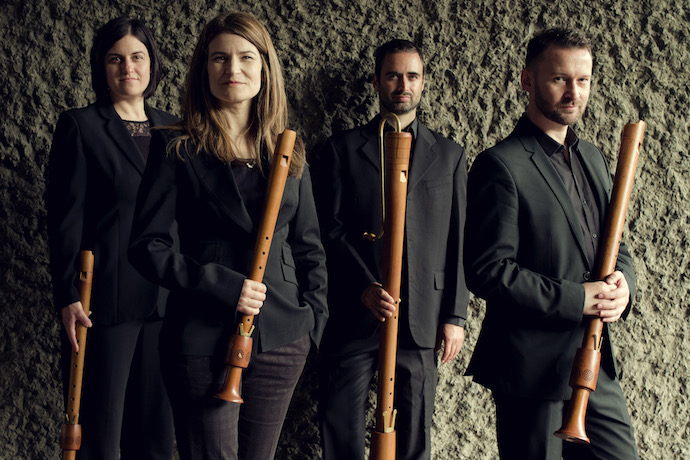
The Flautadors, 2017, photo: David Bebber
Milton Court Concert Hall, London
By Richard Whitehouse
Since its formation in 1997, The Flautadors has been at the forefront of recorder consorts and this programme, given as part of the Guildhall’s Alumni Recital Series, proved a judicious mix of ancient and modern as defines the now expansive recorder repertoire.
The first half featured music from the ensemble’s latest disc Bavardage (just released on First Hand Records) – not least Idyll 1 by Japanese composer Ryohei Hirose, whose sensuous use of Indian harmonic procedures was as arresting as the ritualistic stage presentation. It framed a sequence that concluded with two other contemporary pieces. Leo Chadburn’s De La Salle deployed a variety of intervals (and instruments – with each musician playing Ornette Coleman-style on two recorders) in its unfolding of intricate textures. With its delicate interplay of recorders and triangles, Arbos is the most understated of those mid-1970s works with which Arvo Pärt completed his transition from an angst-ridden modernism to an embrace of the distant past with profound consequences for western music. In between came a selection of chansons by Guillaume de Machaut, their allure complemented by the rhythmic verve of items by Purcell; a typically methodical In Nomine by Byrd, then arrangements of the fourth and ninth contrapuncti from Bach’s Art of Fugue, whose dextrous realisation made one hope for an integral performance (and recording) from these musicians.
The second half focussed on more overtly entertaining fare, with the quartet being joined by up to nine other recorder players and three percussionists for a heady traversal through songs and dances from the Renaissance and early Baroque. Much of this music is as visceral in its impact as recorder music gets, but room was found for such as the harmonically intriguing Ashton’s Mask by Hugh Ashton, the inimitable Lachrymae Pavane by Dowland (as arranged by Jacob van Eyck) and, from among numerous inclusions by Anthony Holborne, a rapturous Pavane and the chameleon-like textural changes of Paradiso. All very diverting, not least as rendered with such obvious technical accomplishment and infectious enjoyment on a now crowded Milton Court platform by these musicians.
A programme such as this is worthwhile not merely in terms of the music and performers, but for the opportunity to see (and hear) so many recorders being utilised, not least the plaintive Norwegian sea flute and the resonant undertones of the formidable-looking Contra Bass recorder. This is an assembly such as one would be unlikely to see in any other instrumental context. Hopefully The Flautadors will be convening again, and soon, to present further classics as well as commissions from their vast and ever-increasing repertoire. ![]()